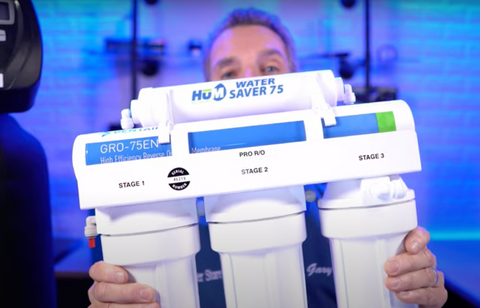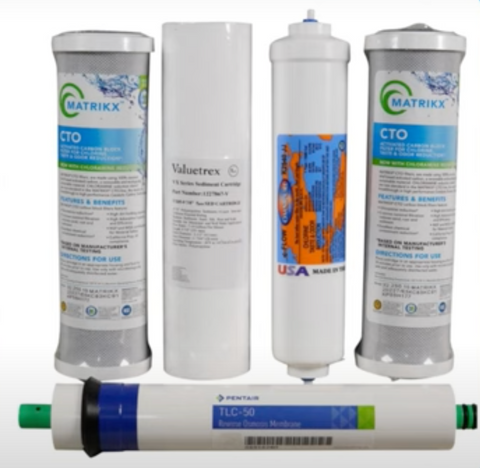
Are you in search of expert advice on maintaining your Reverse Osmosis (RO) Drinking Water System to ensure a continuous supply of super pure water for your family? Look no further! This blog post is tailored just for you.
Matthew and I will unveil our top tips and tricks for effectively maintaining your Reverse Osmosis Drinking Water System. By the end of this blog, you'll have a clear understanding of where to begin, the necessary tools and equipment, as well as the proper methods and schedule for maintenance. Consider yourself a pro in no time! We'll also highlight some common pitfalls to avoid so you can ensure optimal RO system performance.
GETTING STARTED

Really, the first step is to know what make and model of Reverse Osmosis (RO) system you currently have in your home, cottage or cabin. This is definitely not easy to do as so many of them do not have the make and model number displayed. Most RO systems are similar in design and manufacture and even use the same replacement filters and membrane, but each brand has their own specific maintenance nuances.
>> This video will help you choose the correct filters for your RO: WATCH NOW
If you don’t have any idea what replacement filters and membrane you need to get your maintenance completed, just email us some pictures of your RO system and we can identify it for you!
Reverse Osmosis Drinking Water System: What Is It?
If you're on a quest for super pure, safe drinking water, a Reverse Osmosis Drinking Water System is what you need. RO systems are designed to remove up to 90% of the impurities found in your water, making it cleaner and healthier for you and your loved ones. Say goodbye to chemicals like chlorine, chloramines, and fluoride, as a Reverse Osmosis Drinking Water System effectively filters them out, ensuring that what you drink is free from these unwanted substances.
 Not only does an RO system provide you with high-quality water, but it also helps eliminate the waste and environmental impact caused by disposable water bottles. By investing in a Reverse Osmosis Drinking Water System, you're taking a step towards a more sustainable lifestyle while enjoying the convenience and peace of mind that comes with having pure, refreshing water right at your fingertips.
Not only does an RO system provide you with high-quality water, but it also helps eliminate the waste and environmental impact caused by disposable water bottles. By investing in a Reverse Osmosis Drinking Water System, you're taking a step towards a more sustainable lifestyle while enjoying the convenience and peace of mind that comes with having pure, refreshing water right at your fingertips.
- Provides super pure, safe drinking water
- Removes 90% of the impurities in your water
- Removes chemicals like chlorine, chloramines and fluoride
- Eliminates the waste and environmental impact of disposable water bottles.
Types of RO Systems
-

Standard Efficiency RO Systems: These systems are designed to efficiently remove impurities from your water, providing you with clean and pure drinking water. They offer a reliable and cost-effective solution for your household's water filtration needs.
-
High Efficiency RO Systems: With advanced filtration technology, high-efficiency RO systems not only remove contaminants effectively but also optimize water usage. These systems are designed to minimize wastage and maximize the production of purified water, making them environmentally friendly and cost-efficient.
-
High Flow RO Systems: If you require a larger volume of purified water, high flow RO systems are the way to go. These systems are specifically designed to deliver a higher flow rate, ensuring a steady supply of purified water for your household or commercial needs without compromising on water quality.
-
Remineralization RO Systems: While reverse osmosis is highly effective at removing impurities, it also eliminates some essential minerals from the water. Remineralization RO systems solve this issue by reintroducing beneficial minerals back into the purified water, ensuring a healthy and balanced drinking water experience.
Basic RO Maintenance Process

Maintaining your Reverse Osmosis (RO) system doesn't have to be a daunting task. In fact, with just a few simple steps, you can ensure that your RO system continues to provide you with clean and pure drinking water.
The basic RO maintenance process involves closing the shut-off valve before the system and tank, depressurizing the system by opening the faucet, then opening up the housings to replace the old filters one at a time. Don't forget to apply some grease to the o-ring before replacing the filter with a new one.
Once everything is in place, simply close it back up and tighten it by hand until secure. Then, give it a little extra tightening, ensuring that it won't leak.
By following these straightforward steps, you'll keep your RO system running smoothly and enjoy the benefits of fresh, filtered water for you and your family.
RO System FAQ
-

How often does an RO system need to be maintained?
The maintenance frequency of an RO system varies depending on factors such as water quality and usage. Generally, pre-filters should be replaced every 6 to 12 months, while the RO membrane may only need replacement every two to three years.
This video that shows you how you to know when to change the membrane. >> WATCH NOW
-
What service does an RO system need?
Regular maintenance for an RO system includes replacing pre-filters, post-filters, and the RO membrane as needed. Additionally, checking for chlorine levels and following water treatment guidelines is crucial. -
Can I service an RO system myself?
Yes! With our easy-to-follow water treatment system maintenance videos and pro tips available at GarytheWaterGuy.com you can perform routine maintenance on your RO system at home. Just be sure to seek professional assistance for complex issues or if you're unsure about the process. -
What are common areas of difficulty when maintaining an RO system for the first time?
Some common challenges when maintaining an RO system for the first time include understanding the filter replacement schedule, ensuring proper installation and connections, and troubleshooting any leaks or malfunctions. -
Do you have any tips and tricks from the pros?
Yes! Here are some helpful tips to help maintain your RO system effectively:- Keep track of filter replacement schedules and set reminders for timely replacements.
- Follow the manufacturer's instructions for cleaning and maintenance.
- Regularly check for any leaks or unusual changes in water quality.
- Check out DIY videos like this one and this one before starting any system maintenance.
- Consider professional servicing for complex issues or if you're uncertain about the process.
RO Maintenance: Tips and Tricks
-
 Filters on average need to be changed once per year.
Less people or water usage, less often; more people, more often.
One-person household - 1 ½ years, up to 4 people in a household - 1 year, 5-8 people in a household, every 6 months.
Filters on average need to be changed once per year.
Less people or water usage, less often; more people, more often.
One-person household - 1 ½ years, up to 4 people in a household - 1 year, 5-8 people in a household, every 6 months.
This video shows you how to replace your RO filters: >> WATCH NOW
-
Membrane needs to be replaced when the system is not reducing the TDS by more than 90%. Typically, anywhere from 2 to 10 years depending on your TDS and if you have a water softener or not. You can check it with a TDS meter like
this one.
This video shows you when to change the membrane: >> WATCH NOW
Looking for more?
I have specific videos on the makes and models of RO drinking water systems that we recommend and sell. Check the links below!
>> How Does a RO Drinking Water System Work? WATCH VIDEO
>> HUM Water Saver 75 Drinking Water System: SHOP NOW
>> Digital TDS Water Meter: SHOP NOW












